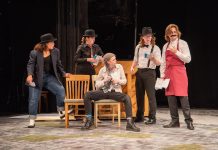Sara Mohsen carried in her backpack a Little Debbie brownie and her mother’s shawarma wrapped in aluminum foil. Mohsen, like many other second-generation immigrants, weaved the cultures of her family’s country with that of her home: America.
Second-generation immigrants are citizens born in the U.S. with at least one foreign-born parent. Immigrants assimilate differently depending on where their family is from, Dr. Jong Bum Kwon, assistant professor of anthropology at Webster, said.
Kwon found one commonality among most second-generation immigrants; they struggled to find their fit and maintain a cultural identity.
Gozie Uzendu and Webster sophomore Kieron Kessler both felt different due to their foreign descents. Uzendu’s parents moved from Nigeria to the United States in the 1980s. Kessler’s mother hailed from the northern Indian state of Punjab, but her father lived in St. Louis.
Kessler said she struggled to fit in with her family due to her lineage.
“On my white side, I’m like the ‘brown kid’ in my family,” Kessler said. “They call me the ‘little Indian princess.’ I’m not ostracised for it, but it’s also always there since I’m not completely white.”
Uzendu said he struggled to relate to other black people in high school.
“I’ve definitely [felt] different, especially around other black people,” Uzendu said. “It’s hard for me to relate to them because we have different backgrounds and see things differently.”
Kwon said he also felt different growing up due to his cultural descent.
The Kwons were one of the few Asian families in a small Wisconsin town, Kwon said. His classmates mocked his name and labeled him as Vietnamese.
“I just wanted to be white,” Kwon said. “I wanted to assimilate. I wanted to be like other people, like anyone else.”
Kwon received his doctorate in anthropology from New York University in 2005. He studied race and second-generation immigrants in his career.
According to Kwon, immigrants of European descent tend to experience less cultural conflict. Webster alum Goran Orescanin felt this to be true as he grew up in St. Louis.
Orescanin was born in 1995 in a small Serbian village outside of Kraljevo. His parents fled their home country during a civil war when he was two years old. Orescanin said he feels more American than Serbian.
“I’ve become really Americanized, but being Serbian is something I’ll never be able to escape from,” Orescanin said. “It’s permanently a part of my identity. It makes me feel different sometimes but not like a bad different.”
Like Orescanin, Mohsen said she identified as both American and the culture of her parents equally.
Mohsen’s parents immigrated to the United States from Lebanon in the early 1980s. Mohsen lived her early years in St. Louis, but also lived in Lebanon from age five to 13.
“I can’t compare the two,” Mohsen said. “I do live my parent’s lifestyle and still have their basic roots, but at the same time I’m American. I like my pizza, burgers and donuts.”
However, Mohsen struggled at a young age to consolidate her Lebanese roots with her American surroundings.
She said some students at her schools such as the Academy of Sacred Heart and St. Louis Community College treated her differently because she wore a hijab.
“I am different here,” Mohsen said. “I am different when I go to Lebanon, so I thought, ‘Who am I?’ I came to the conclusion that I am not only Lebanese, I am also American.”
Friends and family who share the same religion as Mohsen helped cultivate her knowledge of Lebanese culture. Mohsen practiced Islam and went to mosqué with her friends.
A commonality across all second-generation immigrants is the battle to figure out who they are, according to Kwon. He said most children of immigrants shed the cultures of their parents.
“You have to question this entire bottle of assimilation,” Kwon said. “Why should we try to become American and forget our past? Why can’t we celebrate our differences and still be American? The question is, was it all worth it?



